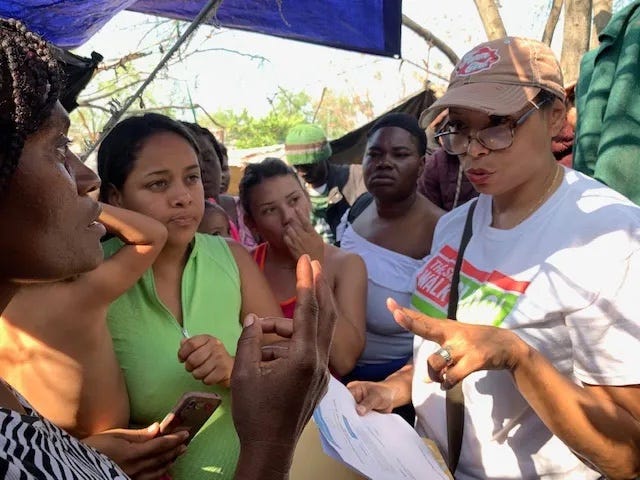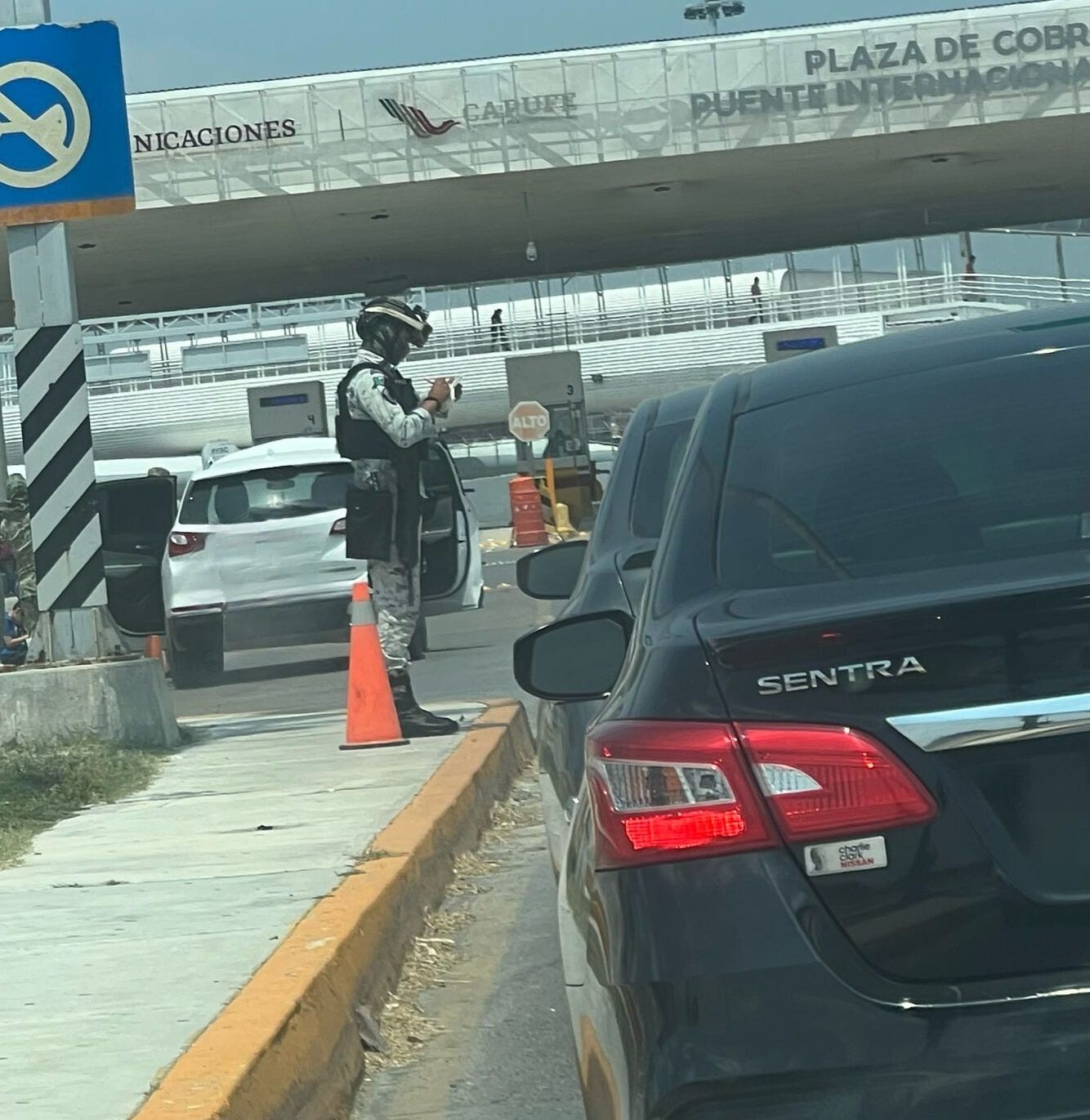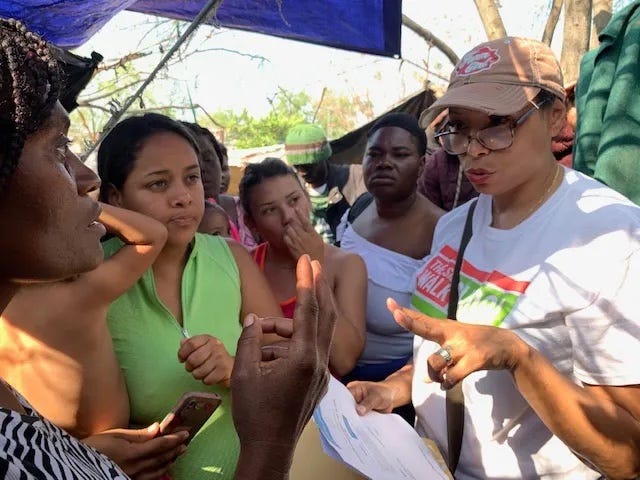
In 2019, Felicia Rangel-Samporano, a stay-at-home mom in Brownsville, Texas, joined forces with Victor Cavazos, a software engineer, to start the nonprofit Sidewalk School and provide Montessori-style educational programs for children in the process of migrating.
Over the years, The Sidewalk School has adapted to the tremendous need of migrant families in Matamoros and Reynosa, Mexico. They helped open a shelter in Reynosa, so that people wouldn’t have to live in migrant camps, and they have been especially focused on helping Haitians and other Black migrants who often face discrimination and greater difficulty finding assistance and housing. Over the years they’ve provided food, medical services, and even tech troubleshooting for the U.S. government’s CBP One app, which asylum seekers in Mexico were required to use to request an appointment with U.S. border officials, before Trump turned it into the self-deportation app CBP Home.
The Border Chronicle checked in with Rangel-Samporano to get a sense of how things are changing in the stretch of border in South Texas-Tamaulipas where The Sidewalk School runs its programs.
As a cofounder of The Sidewalk School you often go to Reynosa and Matamoros in Tamaulipas. How are things looking there these days. Is Sidewalk School still serving families there? Or is everyone gone?
Most of the people who had CBP One appointments, have gone, except for one family.
I’m not going to say which city this family is in, but it’s a family that had a CBP One appointment for February 9, and the parent believes that somehow the US is going to honor that appointment, and they are still there waiting. There are still some people in the shelters but no one else is seeking asylum in the U.S.
The majority of them are from Latin American countries. And then you have a handful of Haitians in both cities, like a very small handful in both cities, but they’re not trying to come to the U.S. either. They just need some time to work, save money, and make plans to go to another country.
Was it difficult when all of the CBP One appointments were canceled. How did you deal with that? And what kind of situations were people in?
January and February were very difficult because there were so many questions and it’s difficult even for an American to explain what’s happening with our government, we live in chaos, we are just bombarded from morning to night with chaos in our own country. So to have to try and explain that to someone from another country, especially when they’ve heard for so many years how great and welcoming the U.S. is, and then all of a sudden, they’re hearing about and seeing violence from the U.S. towards immigrants. And so January and February were very difficult. There were a lot of questions, a lot of disbelief. Going into March, no one could believe what was happening in the U.S., and they felt, for some reason, like it wouldn’t happen to them, and that there was still a chance they could come to the U.S. and request asylum. At the Sidewalk School, we’re not lawyers so we don’t advise or get involved with legal questions about asylum or anything like that, we only tell them what we are hearing and reading in the news. We never take away hope. I mean, that’s our whole thing. If you don’t have it, then what are we doing this for?
But by April, I can tell you the tone had changed. People were no longer seeking asylum in the U.S. I recently heard from one man that he was waiting for family members from the U.S. His brother-in-law was being deported and so his sister and her kids were homeless and had no food. They were going to self deport to Mexico to be reunited, then figure out where to go next.
Instead of families waiting in Mexico for their asylum cases, do you think you’re going to increasingly see families who are are being deported from the U.S.?
No, the families who are deported from the U.S. are not being sent to Matamoros or Reynosa. The Mexican border cities are mostly empty, so people who are getting deported, they’re not stopping here, they are being taken directly to their home country or into the interior of Mexico.
Will you continue providing services then?
We’ve never stopped providing services. Right now, we are providing education to homeless children in Mexico.
The folks that are homeless, are they trying to figure out what to do or where to go, because they were left in limbo after their CBP one appointments were canceled or they couldn’t get one?
So the people we speak to now, they don’t have them [CBP One appointments], but they’ve somehow made it to the border. They wanted to be close enough to hear and see for themselves that all of what they were hearing was true. That there’s no hope for any asylum or any type of status in the U.S. anymore. And they, the parents we spoke to, got it. They were like, “Okay, we’re going someplace else.”
Haitian families, I imagine, are in an especially tough spot, right? Because they really don’t have anywhere to go, they can’t go back to Haiti, and a lot of them already left South America after settling there. Are they choosing to stay in Mexico?
Many of the Haitians who have decided to settle in Mexico, they got here before HIAS, and all the other legal organizations left the border.
The Haitians were quick enough to get their residency in Mexico. And so once they were legally in Mexico, that’s when they started moving as couples and families together to share houses and apartments and purchase cars.
Not long ago, two families came back to the shelter to visit Victor and me. These nicely dressed Haitian women in a nice car. And I told them “I’m really happy to see y’all are doing so well.” They had come to ask for our help because they wanted to enroll their children in school but the private schools in Matamoros would not enroll their Black children, and they felt they were being discriminated against. They were working, and willing to pay but they still couldn’t get their kids enrolled.
Were you able to help them?
I’m happy to say that they were able to enroll their children in school.
That is great news. How many kids or families are you helping now?
Our classrooms are full. Most kids have been in Mexico for so long they are now enrolled in school but there’s no pre-K here, so we have a lot of little ones, and then their older siblings come when they get out of school. Most come for the food, which is fine with us.

You recently had an experience at a port of entry in Reynosa that was different from what you’ve experienced in the past, and it was with the Mexican military. What happened, exactly?
I was driving back to the U.S. from Reynosa at the Hidalgo bridge. And the wait was about three hours. This is because they had the military there doing inspections before, we could cross back into the U.S., which was a first. They aren’t doing this in Matamoros.
A Mexican soldier asked me to stop my car, and he was holding a notebook and pen, and he said he wanted my first and last name, which he wrote down. Then he wrote down my license plate number, then he walked back, I assume to get the make and model of my car. Then he asked me to get out of the car, and he pointed where he wanted me to stand. There was a woman already there waiting. Her car had Mexican plates —a little four-door sedan — and the soldiers had surrounded it and had the hood up and were looking at her engine.
Other soldiers were taking the grocery bags out of her car. She looked like she’d been there for a long time. Even when I drove away, they were still in her engine. Finally, they let me go and then I drove to the midpoint [on the international bridge] where there’s the U.S. immigration officer from Customs and Border Protection who then asks another set of questions. That’s when I started showing my frustration and anger, because I was very upset.
Because you waited for so long, handed over all that info, only to be asked for more by the U.S. immigration agent? I believe the military are doing the same thing in Tijuana, though it’s not at all of the port of entries. I don’ t know why.
To me it was clear that the U.S. was directing Mexico to inspect every car that was headed into the U.S. without any explanation or warning. And also, what are the Mexican military going to do with this information? We have no idea. It’s just more chaos.
 Read more: Read More
Read more: Read More




